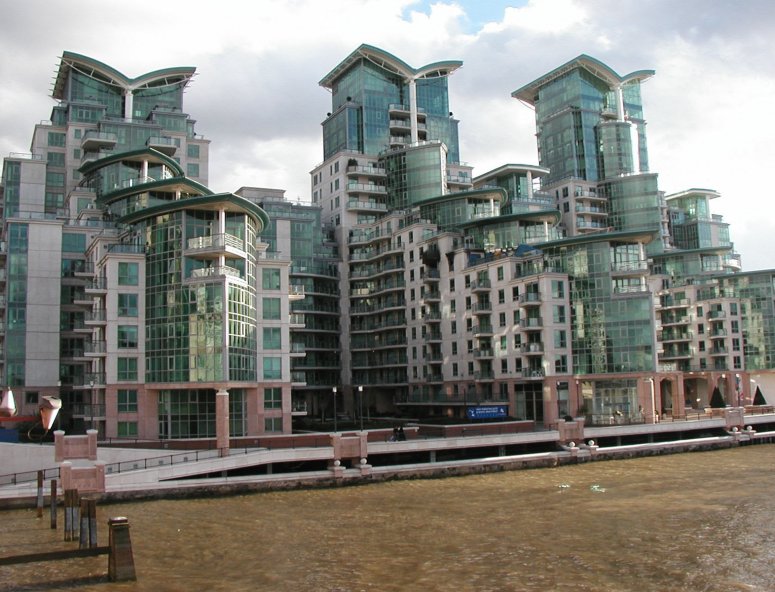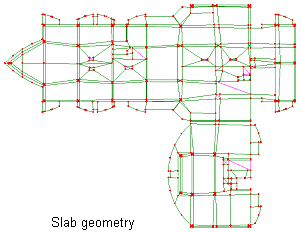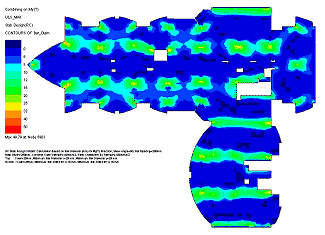Case Study
Slab
design on the St George Wharf Development
- Irregular shaped in-situ
floor slabs
- Reinforced concrete slab design wizard
used to produce reinforcement bar contours
- Detailing process improved

White
Young Green is provided civil and structural design for the 2nd-5th phases of the
St George Wharf development in London. LUSAS Civil & Structural
was used to assist with the detailed design of numerous
irregular-shaped in-situ reinforced concrete floor slabs in the
residential tower blocks. The LUSAS RC slab design facility proved
particularly useful in providing accurate contour plots of
reinforcement bar diameters to aid with the detailing of each
unique floor slab arrangement.
Overview
| St George Wharf is a mixed use riverside development of offices, shops, a hotel and residential, situated on the South bank of the River Thames next to Vauxhall
Bridge in London. The residential part of the scheme comprises a
number of multi-storey tower blocks having a reinforced concrete
frame built on piled foundations. Floors are of in-situ reinforced
concrete. Pre-cast balcony slabs and wall panels help reduce
construction time to the minimum. Floor layouts are different all
the way up the towers requiring each to be modelled separately in
LUSAS. Numerous holes and irregular slab shapes meant that using
the simplified design methods for flat slabs in British Standard
BS8110 was just
not possible - hence the use of LUSAS and its RC slab design
facility to produce the results in the time available. |

|
| |
|
|
Floor modelling
Slab geometry for each floor comes
from Autocad via a DXF file. Tim Dodd of White Young Green
explains the process involved: "We strip-out all irrelevant
geometry from the Autocad file and create a DXF file for import
into LUSAS. Then we apply a regular mesh arrangement, add supports
and loading, and analyse and process the results using the RC slab
design facility."
|

|
| |
|
| Large-scale line or
colour-filled
contour plots are produced from LUSAS to enable direct measurement
and scaling of extents of bars. If bar contour plots from LUSAS
are set to show, for example, T12’s at 150 centres
across the whole slab, areas where additional steel is required
can be easily identified. Tim Dodd adds: "The main benefit of
using LUSAS on this project is that it handles all the complicated
flat slab geometry and holes, produces bar reinforcement contours,
and enables us to design slabs almost impossible by hand." |

|
A conservative approach to
modelling the column supports results in two models being required
for each floor level. In one model simply supported column
supports are used to give worst-case span moments, and in the
other, restraints at column positions give worst-case hogging
moments over supports. This method avoids the high peak hogging
moments that can sometimes result when a single support is used to
represent a column position. Potential slab deflections, and
early striking of concrete was also investigated with LUSAS. On-site measurements of slab deflections compared very favourably
with LUSAS predicted values.
White
Young Green was also
involved in the design of a commercial office facility and a hotel
on the site as well as providing initial design advice to its
client, St George plc, for a proposed 181m high, 49 storey
residential tower to the south of the residential blocks. For the
tower a 3D LUSAS model was used to evaluate lateral
deflections of shear walls.

"The main benefit of
using LUSAS on this project is that it handles all the complicated
flat slab geometry and holes, produces bar reinforcement contours,
and enables us to design slabs almost impossible by hand."
Tim Dodd, Project
Engineer, White Young Green
Find out more
Other LUSAS Civil &
Structural case studies:
|
|
Software Information
|